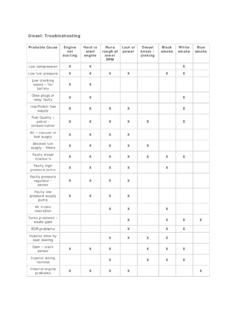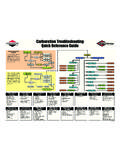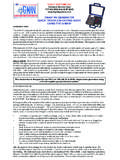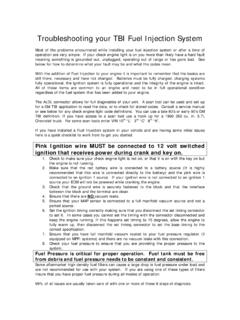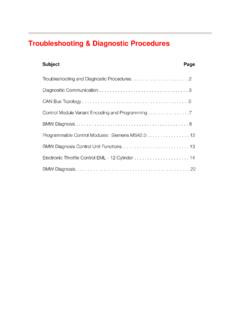Transcription of Model A Ford, Zenith Carburetor Troubleshooting …
1 Troubleshooting chart Model a ford , Zenith Carburetor Troubleshooting chart Common Symptoms Opening GAV does not provide extra fuel at low speeds Low mileage / Sooty plugs / Mixture rich / Smell gas Engine won't idle smoothly at 350 to 450 RPM. Miss and jerks on hard pulls at low speeds Problems when driving over 30 to 35 MPH. Engine dies when vehicle comes to a stop Problems when driving 5-35 MPH. Mixture lean and over heating Gas Leaks from Carburetor Back fires at high speeds Common Causes Loose fuel line fitting, drain plug, filter strainer, GAV, Passage plugs, x Float is set too high or a pin hole absorbs gasoline into float. x x Float Valve does not seat properly due to dirt, rust or material failure.
2 X Gaskets are not sealing properly. x Gasket at Main Jet is too thick or multiples are used, resulting in tip being too low. x x Main Jet or Cap Jet Tip is not "dished" / "indented". x Vacuum leaks at manifold gaskets, wiper line, or throttle shaft. x Throttle Idle Adjustment Screw is mis-adjusted. x x Idle Air Adjust Screw is mis-adjusted or too short, collapsing spring before it seats. x x Upper Casting Idle Jet Passage is restricted to Idle throat port. x x Upper Casting Air Adjust Screw Passage is restricted to vent hole. x Idling Jet Orifice contains dirt or rust, or is too small. x x Idling Jet Orifice is too large. x Gas Adjusting Valve is open too much or seat is not honed to let needle seal.
3 X x Gas Adjusting Valve Brass Seat is missing from carburetors built through 1929. x x Lower Casting Bowl Passage is restricted to Secondary Well via GAV Seat Hole. x x Lower Casting Comp. Jet Passage is restricted to Cap Jet via Secondary Well. x x x Compensator Jet Orifice contains dirt or rust, or is too small. x x x x Compensator Jet Orifice is too large. x x Float is set too low. x x x Lower Casting Bowl Passage is restricted to Main Jet & Drain Plug. x x Main Jet Orifice contains dirt or rust, or is too small. x x x Upper Casting Fuel Line Passage is restricted to Float Valve via Filter Strainer. x x Gas Adjusting Valve Seat is blocked with dirt or rust. x Air Filter is restricting air flow.
4 X Chris Pelikan Sat, 18 Dec 2004 12:00:00 MST.
